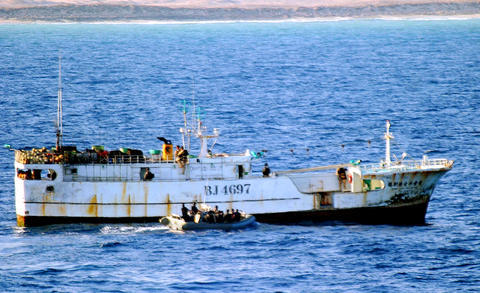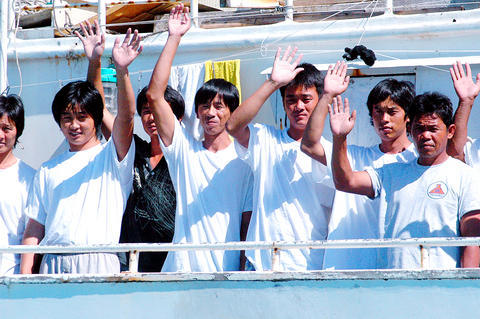With one murdered crewman in the ship's freezer and Somali pirates threatening to execute his son, Captain Lin Sheng-hsin (林勝信) could think of only one thing to do: threaten to throw himself into the shark-infested waters.
Four pirates immediately rushed to keep him from jumping from the fishing vessel.
"It was a test. I wanted to see how much the pirates valued me .... They know if the captain dies, they will get less ransom," the 47-year-old said in an interview this week, safe in Kenya after the US Navy forced the pirates to release the Ching Fong Hwa 168 and its surviving crew, including Lin's 22-year-old son.

PHOTOS: AP
Lin's tale of seven months of detention by pirates on his own ship is frighteningly common off Somali, a part of the world where high seas crime is on the increase. The pirates made off with an unspecified ransom paid by the owner of the ship.
But Lin's story has a twist. After even more ransom was demanded, the US Navy stepped in, forcing the pirates to release the Ching Fong Hwa 168 and its surviving crew.
A Navy spokeswoman said such intervention would continue in response to the spike in piracy in the region.

PHOTO: AP
"The worst time for me was the times they took my son ... they used this boy," Lin said, gesturing at the shaggy-haired Lin Shang-yu (
"They threatened me, said if I didn't call Taiwan they would shoot my son," he said.
Although there has been a spate of pirate attacks off the lawless coast of war-ravaged Somalia -- 26 so far this year, up from eight during the same period last year, the International Maritime Bureau says -- deaths are rare, says Andrew Mwangura, head of the East Africa Seafarers' Assistance Program.
"Most of the time the pirates want money, not to kill people," he said.
Ransoms can reach millions of dollars.
Somalia is deeply impoverished and flooded with weapons. It has long been without a central government with much authority on land, let alone the means to police its long coast. And now, the shaky government is busy battling an Islamic insurgency.
Pirates are often trained fighters linked to the clans that have carved Somalia into armed fiefdoms.
They have heavy weapons and satellite navigation equipment, and have seized merchant ships, aid vessels and even a cruise ship.
Lin's encounter with Somali pirates began one sunny April afternoon, when about 15 of them stormed aboard armed with automatic rifles, machine guns and rocket propelled grenades. Lin's crew was unarmed, and one member was shot in the back. He survived, but when negotiations with the ship's Taiwanese owners were going badly, the pirates executed Chen Tao, 32, from China.
"He was very unlucky because they just took him at random," recalled Lin, who had worked with Tao for two years.
He remembers the young sailor being grabbed out of a lineup, then the six shots that rang out on the other side of the boat.
"We were in shock," muttered the weathered captain, one dragon-tattooed arm reaching up to smooth a sprinkling of white hair.
"Just for money they took a life ... they are not human," he said
"After they shot that guy, I was really afraid," said Lin Shang-yu, reaching out to refill his father's sake glass.
Four crew members were ordered to drag the bloody body into the ship's freezers, where Lin insisted it stay. The pirates wanted to throw it to the sharks.
Over the next few months, the crew battled scurvy when their vegetables ran out, endured frequent mock executions and occasional beatings from guards when the Chinese, Taiwanese and Filipino crew didn't understand orders in Somali and broken English.
The pirates also forced crew members to call home, in hopes the families would pressure the ship's owners to pay the ransom. Lin listened to his wife weep for her son and husband.
Eventually, Lin explained through a translator, the ship's owners paid up last month -- the pirates had demanded US$1.5 million, but Lin refused to say how much was paid.
Everyone thought they were going home, but the pirates held out for more money. That's when the Americans got involved.
The US Navy said its personnel spoke with the pirates by radio, pressing them to leave.
They did so on Nov. 5, by skiffs that took them to shore. Then a US Navy vessel escorted Lin's ship out of Somali waters and provided its crew food and medical assistance.
Lin, who speaks no English, was unclear on who had helped, saying he believed "UN" forces as well as the US military was in the area because of the pirate activity.
US officials won't say exactly what they said to persuade the pirates to leave. But earlier, a US vessel had fired on pirate skiffs tied to a Japanese-owned ship.
At one point in recent months, at least seven ships were being held. Now, following US intervention, only two remain in pirate hands.
US Navy spokeswoman Lydia Robertson said: "Since we were there when the ships were pirated it was an opportunity for us to stay there and help free the ships."
Indonesia remains the world's worst piracy hotspot, with 37 attacks in the first nine months of this year, the International Maritime Bureau said.
Pirate activity is on the rise, with the biggest increases off Africa, and particularly Somalia.
On Wednesday, the crew of the Ching Fong Hwa 168 tucked into lobsters and chicken at the Chinatown restaurant in downtown Mombasa.
Their ship was safely in port, their families had been informed, and the men were enjoying their first taste of freedom -- and sake -- in over half a year.
"To freedom," toasted one man in Bermuda shorts and cheap plastic flip flops.
Another replied, "To home."

SHIPS, TRAINS AND AUTOMOBILES: The ministry has announced changes to varied transportation industries taking effect soon, with a number of effects for passengers Beginning next month, the post office is canceling signature upon delivery and written inquiry services for international registered small packets in accordance with the new policy of the Universal Postal Union, the Ministry of Transportation and Communications said yesterday. The new policy does not apply to packets that are to be delivered to China, the ministry said. Senders of international registered small packets would receive a NT$10 rebate on postage if the packets are sent from Jan. 1 to March 31, it added. The ministry said that three other policies are also scheduled to take effect next month. International cruise ship operators

NUMBERS IMBALANCE: More than 4 million Taiwanese have visited China this year, while only about half a million Chinese have visited here Beijing has yet to respond to Taiwan’s requests for negotiation over matters related to the recovery of cross-strait tourism, the Tourism Administration said yesterday. Taiwan’s tourism authority issued the statement after Chinese-language daily the China Times reported yesterday that the government’s policy of banning group tours to China does not stop Taiwanese from visiting the country. As of October, more than 4.2 million had traveled to China this year, exceeding last year. Beijing estimated the number of Taiwanese tourists in China could reach 4.5 million this year. By contrast, only 500,000 Chinese tourists are expected in Taiwan, the report said. The report

Temperatures are forecast to drop steadily as a continental cold air mass moves across Taiwan, with some areas also likely to see heavy rainfall, the Central Weather Administration (CWA) said. From today through early tomorrow, a cold air mass would keep temperatures low across central and northern Taiwan, and the eastern half of Taiwan proper, with isolated brief showers forecast along Keelung’s north coast, Taipei and New Taipei City’s mountainous areas and eastern Taiwan, it said. Lows of 11°C to 15°C are forecast in central and northern Taiwan, Yilan County, and the outlying Kinmen and Lienchiang (Matsu) counties, and 14°C to 17°C

STEERING FAILURE: The first boat of its class is experiencing teething issues as it readies for acceptance by the navy, according to a recent story about rudder failure The Hai Kun (海鯤), the nation’s first locally built submarine, allegedly suffered a total failure of stern hydraulic systems during the second round of sea acceptance trials on June 26, and sailors were forced to manually operate the X-rudder to turn the submarine and return to port, news Web site Mirror Daily reported yesterday. The report said that tugboats following the Hai Kun assisted the submarine in avoiding collisions with other ships due to the X-rudder malfunctioning. At the time of the report, the submarine had completed its trials and was scheduled to begin diving and surfacing tests in shallow areas. The X-rudder,